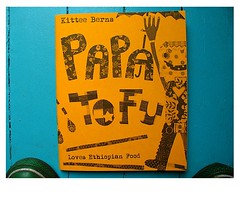How to Make Kimchi
By Renae Myers
Hi! I’m Renae. I’m flattered to have been asked to do a guest post for xgfx.org about making kimchi. I consider fermentation my specialty. I’m not much an expert at baking vegan cupcakes, but I do know how to make an awesome pickle. And what’s more, many pickles are naturally vegan and gluten-free. Kimchi is a great introduction to pickles and fermentation because it’s easy and you don’t have to wait very long for the results. It’s also extremely flexible and usually tastes great no matter what you do.
Kimchi is often – but not always – made with fish sauce and/or other seafood products. When fish sauce is not used, soy sauce is often used as a substitute. This makes it challenging to purchase kimchi that is both vegan and gluten-free. But it’s also really easy to make at home using wheat-free soy sauce or tamari.
Kimchi
Ingredients
1 head napa cabbage
salt (about 1/4 cup)
1 bunch mustard greens (optional)
1 large or 2 medium carrots, julienned or grated (optional)
1 daikon, julienned or grated (optional)
6 cloves garlic, minced or pressed
1 thumb-sized piece of ginger, minced or grated
1 bunch scallions, chopped
1/4 cup wheat-free tamari
1/4 – 1/2 cup Korean red chili pepper flakes
Special Equipment
1 gallon-sized jar, or 3-4 quart jars with lids or
kimchi pot
A lot of kimchi you can buy in stores is made from a whole head of cabbage. Although I believe that is the traditional way to make kimchi, it’s annoying to deal with (I always end up cutting it with scissors) when you want to eat it. So when I make my own, I chop it into bite-sized pieces to begin with. I think it’s easier to make that way, and it’s definitely easier to eat. First, chop the head of cabbage in half.
Then remove the core from each half.
And finally, chop it into bite-sized pieces.
Like many pickled and fermented foods, kimchi originated as a way to preserve food. Salt is used to preserve the kimchi in the beginning stages of fermentation, before the lactic acid that will preserve it later has been produced. The standard rate at which you should salt food you wish to preserve is 5%, either as part of a brine (i.e., mixed into water) or rubbed dry into the vegetable. So if you have a kitchen scale, weigh your chopped cabbage:
then find 5% of that weight and weigh that much salt.
If you don’t have a scale, 1/4 cup of salt is about right for a medium head of napa cabbage.
The next step is to treat the cabbage with the salt. There is a dry method and a wet method to doing this. I often use the dry method, but I’ve gotten some feedback from others who have reported overly dry kimchi when using the dry method, so for this batch, I used the wet method, which means I used a brine. Because I didn’t have a bowl large enough to hold my cabbage, I plugged up my kitchen sink, dumped the chopped cabbage into it, and then sprinkled the salt over it, mixing it well.
Pour enough water over the cabbage to just cover it and let it sit for anywhere from two to 24 hours. I soaked mine for about four hours.
If you’d like to try the dry method of salting the cabbage, rub the salt well into the cabbage pieces, place them in a colander, and then place a weight over them – a large plastic bag filled with water makes a perfect weight. (Pro tip: salt the water in the plastic bag so you don’t dilute the salt on the cabbage if it leaks.)
Meanwhile, prepare the rest of the ingredients. I marked a lot of them as optional in the ingredients list because although they are the vegetables I most often include in my kimchi, there are no ingredients you must, or must not, use. Feel free to make substitutions – Kittee tells me she adds cauliflower to hers, which I’m excited to try. Whatever you choose, just chop it into bite-sized pieces, or grate it. If you can find them (try an Asian market), mustard greens are a common ingredient that provide a bit of a bite. I chop them into sizes similar to the cabbage pieces:
I chop the green parts of the scallions into pieces about 1″ long; the white parts I chop smaller.
Carrots add a subtle sweetness. I usually grate mine:
Ditto the daikon (also available in Asian markets).
And while I’m in a grating mood, I grate the ginger as well:
The world seems to be divided into people who love garlic presses and people who hate them. I’m one of the former, but if you are the latter, mince away.
One of the reasons I like my vegetable cleaver:
Combine all of these extra veggies in a large bowl.
Add the chili pepper flakes. They are easy to find and very cheap in Asian markets. If you don’t live near an Asian market, you may be able to find them online. I found them on H-Mart’s website, but because there are several H-Marts near me, I’ve never purchased anything from their website. Korean red pepper flakes have a different (milder) taste than the chili pepper flakes you may be used to putting on pizza, etc., so, it’s fairly important that you seek them out if you want your kimchi to taste “right”.
Pour the tamari into the bowl as well and mix everything up. I find it easiest to do this with my hands, although the chili pepper flakes may sting a little if you aren’t used to it. The pepper flakes and tamari will make a paste.
When the cabbage is finished soaking, rinse and drain it well. I let it sit in a colander for 10 minutes.
Then add the cabbage to the other veggies and mix well; again, I just use my hands.
Put the kimchi into a sterilized container (or containers). You can buy inexpensive kimchi pots in Korean grocery stores, but I haven’t seen many of them online. Although I have a kimchi pot, I’ve used a gallon pickle jar that I saved instead, to demonstrate that you don’t need a special pot (and because it’s much easier to photograph the kimchi in it). If you don’t have a large jar, you can use several smaller ones. The container(s) must be very clean, because you only want good bacteria to grow during the fermentation. The easiest way to sterilize the jar is to run it through a dishwasher cycle. If you don’t want to use or don’t have a dishwasher, you can boil the jar in water for a few minutes (or pour boiling water into very large jars).
As it ferments, the kimchi will release carbon dioxide, so leave some space – a couple of inches – for it at the top of the jar, and also screw the lid on loosely.
Leave the kimchi out at room temperature for about three days, then taste it. (If it is very hot in your house, it may be ready in fewer days.) It may begin to bubble, which is normal (it’s the carbon dioxide). It should not become moldy. If it does, throw it away and try again, making sure your jar is sterile and you use a strong enough brine. The kimchi is ready when it tastes good to you. I know that’s a bit nebulous, but there’s just no exact time or indicator that it’s “done”. It’s truly a matter of taste. It should look less like a salad and more like, well, kimchi. The cabbage will be softer and slightly more translucent. It will have a strong odor, but it should be a pleasantly sour smell. If you’re making it for the first time and you’ve never been around kimchi, you may wonder about the difference between good-smelling and bad-smelling kimchi. Although “when it doubt, throw it out,” is generally a useful maxim, if you aren’t sure if kimchi smells good or bad, it’s probably fine. You will KNOW if kimchi is bad; there won’t be any doubt about it.
So whenever it is you feel it’s ready, move it to the refrigerator. Although the kimchi will continue to ferment in the refrigerator (and the flavor will continue to become more complex, and more sour), the fermentation will slow down considerably. After removing some kimchi from the jar to eat, push the remainder back down, gently compacting it a little bit, so it stays covered in the paste/brine, which will keep it fresh. Kimchi will last a considerable time in the refrigerator, at least several weeks, if not months. As long as it does not develop a really bad smell, or grow any mold, it’s safe to eat. If it becomes too strong for you to eat straight, add it to cooked dishes. Kimchi is obviously the perfect accompaniment to any Korean meal, but it’s also good with other Asian meals (particularly Japanese, in my opinion), and a surprising number of Western meals. Try it on a veggie burger, for example. For a very simple, but filling and satisfying, meal, eat it with some rice.
 Renae Myers is the author of I Eat Food, a vegan food blog. After making the switch from lacto-ovo vegetarian to vegan in the 1990s, Renae immediately realized she was going to have to learn how to cook if she wanted to continue eating. An unexpected passion for both making and eating food was born and she’s been a slave to it ever since. A Baltimore native, she currently lives in Northern Virginia with her husband and two cats.
Renae Myers is the author of I Eat Food, a vegan food blog. After making the switch from lacto-ovo vegetarian to vegan in the 1990s, Renae immediately realized she was going to have to learn how to cook if she wanted to continue eating. An unexpected passion for both making and eating food was born and she’s been a slave to it ever since. A Baltimore native, she currently lives in Northern Virginia with her husband and two cats.



 Gluten Free Baked Goods by Courser Farm Kitchen
Gluten Free Baked Goods by Courser Farm Kitchen Tuesday Linkage
Tuesday Linkage Halloween Goodies!
Halloween Goodies! Julie Hasson’s Not So Secret Love Affair
Julie Hasson’s Not So Secret Love Affair

